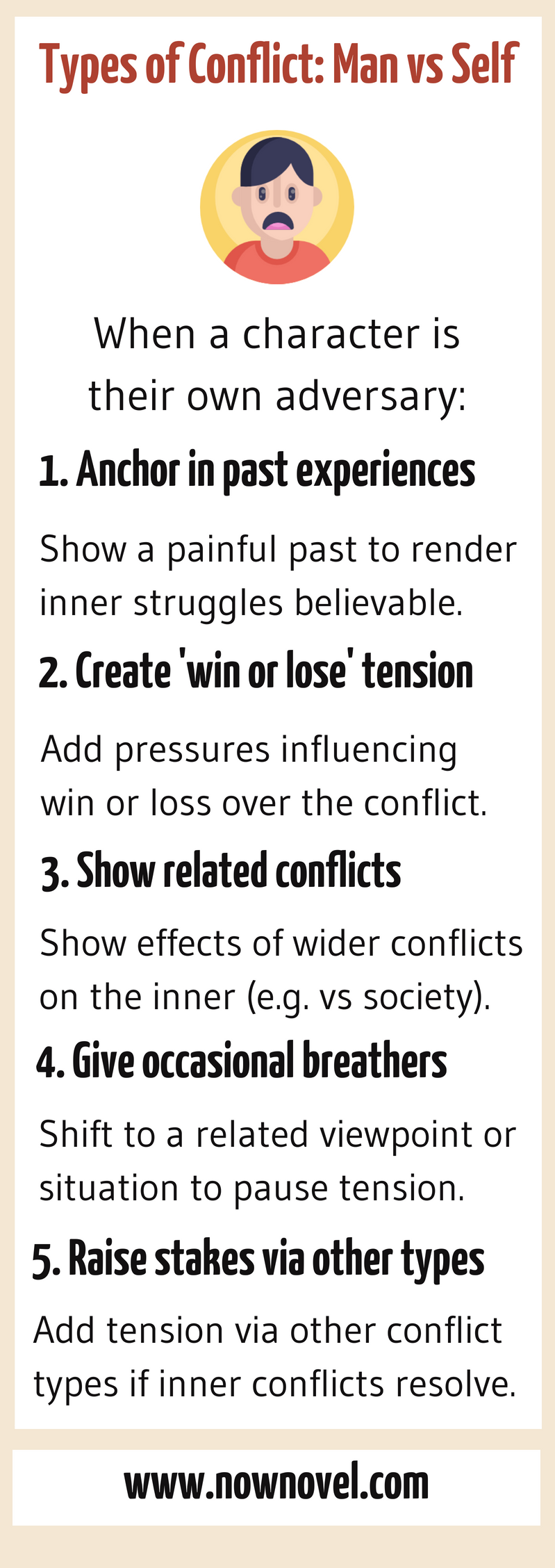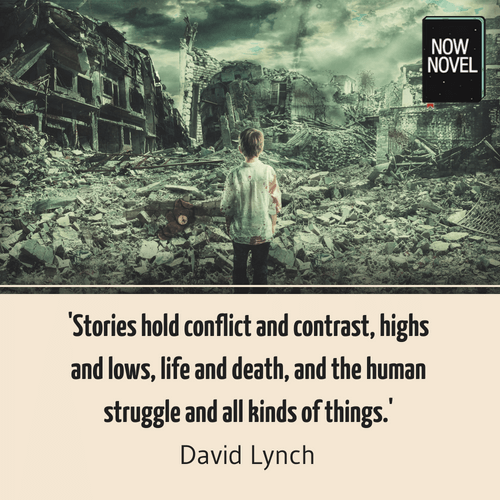One of the oldest and most compelling types of conflict we encounter in stories is man vs self. Man vs self - or person vs self - is a staple of tragedy in particular. In tragedy, a character's ignorance, arrogance or other trait often leads to downfall. Read a definition of this type of story conflict, along with man vs self examples from books:
What is man vs self conflict?
Man (or person) vs self is conflict where a character is their own adversary. This may be the primary conflict of your story - the main obstacle your character has to overcome. Or it could be a secondary conflict that adds extra tension to your primary conflicts.
Person vs self conflict is intriguing because characters who are flawed 'works-in-progress' show complexity. The growth (or spiraling) that many of us experience sometimes in our lives. This type of conflict is compelling because of the uncertainty it creates. Will the character overcome their flaws or destructive patterns? Self conflict is suspenseful because the antagonist - the 'shadow' self - is always present.
So how do you write gripping person vs self conflicts? Here are tips with examples from books:
1. Anchor man vs self conflict in characters' past experiences
A traumatic or misguiding past - a troubled backstory - is a common source of literary conflict. In many novels, we meet characters who are already on the path to winning or losing their inner conflict. [Find more of our best posts on backstory on our character writing hub.]
Placing the origins of your characters' inner struggles in their past experiences is useful because:
- They supply events and explanations you can reveal at your own pace. These may be useful for introducing relevant secondary characters and conflicts
- You're able to create psychological depth and realism. Your readers meet characters who have history, pasts, wounds, scars
Let's take a brief character study example that shows effective man vs self conflict:
In Fyodor Dostoevsky's Crime and Punishment, early in the book the protagonist Rodion Raskolnikov murders a pawnbroker. The ex- law student is living in poverty in St Petersburg, when he decides to kill a pawnbroker he's indebted to.
The murder, the crime of the title, occurs early in the book. Yet Dostoevsky portrays Rodion as deeply conflicted and troubled. We read a portrait of a sensitive young man who is devoted to his mother and sister. Dostoevsky also shows how Rasksolnikov helps a poor woman whose husband is a drunk. He pays for the funeral - albeit with stolen money - when the man is trampled by a horse. Thus he is not a pure 'villain', but a complex, flawed character.
Raskolnikov is torn between the desire to reward those he sees as 'innocent' in the world (the drunk's wife) and those he sees as greedy, inhumane, opportunistic (the pawnbroker).
Thus the conflict is psychological, as we see Raskolnikov justify the pawnbroker's murder to himself by excluding the pawnbroker from the circle of people who are 'innocent' and thus worthy (in his eyes) of mercy.
Why is this person vs self conflict effective?
- It's relevant to the overarching story, arising from a character's core goals and needs: Raskolnikov's desperate need for money gives a clear motivation
- Even after the conflict reaches a peak, there are still intriguing unknowns: Will he be found out and arrested? How will his crime affect Rodion's psyche?
2. Create tension between winning and losing the battle
Part of the pleasure of reading conflict-rich stories is our uncertainty - we want to know what happens.
In person vs self story conflicts, it feels easy if a wave of a wand makes everything well. Even in Cinderella, after the fairy godmother helps Cinderella attend the prince's ball in magical finery,
there is a time-based conflict. We know she has to leave before the illusion - her magical clothing - fades.
Uncertainties and complications can come from many sources:
- External interference: A character who battles addiction, for example, has a 'bad influence', partying friend
- Interpretation and framing: The stories they tell themselves, framing experiences, may influence whether their 'good' or 'bad' self wins. Raskolnikov justifies his murder to himself, even though he knows it is punishable legally, spiritually
- Circumstances beyond characters' control: For example, a character who struggles with mental health and relies on medication for stability
When Raskolnikov climbs the pawnbroker's stairwell, he almost flees when he sees a nearby apartment is being painted. Circumstances beyond the character's control affect his ongoing struggle clearly.

3. Show how related conflicts affect inner struggles
One thing that makes inner story conflicts more believable is showing how they are nestled in and affected by other conflict situations.
An author could simply say, for example, a character is a crazed serial killer. Yet when we understand other, related conflicts - such as a violent upbringing - we understand the longer chain of cause and effect. This greater perspective makes characters fully human (even if their behaviour seems sub-human). It allows richer character portraits.
An example of a related conflict: In Tolkien's The Lord of the Rings cycle, one of Frodo's companions attempts to take the Ring Frodo has been tasked with destroying by force. This character vs character (or man vs man) conflict is important. It casts a shadow of mistrust over the intentions behind future actions of (seeming) friends and foes. It isolates the main character more in his quest.
Bringing in other secondary conflicts increases the urgency of Frodo staying true to his one greatest goal - destroying the Ring - and the additional obstacles make the reader feel the full, overwhelming enormity of just how difficult the character's task is.
Thinking about how conflicts occur within patterns of smaller and larger conflicts will help you create a natural sense of the reasons underlying your characters' inner turmoil.
4. Balance inner turbulence with placid moments
Tension and intensity may become exhausting for the reader if you continue without any let-up. Find moments, subplots, or flashbacks that provide breathers between self-destruction or spiralling.
For example, in Crime and Punishment, there are sections where Dostoevsky switches to the viewpoint of the investigating officer, or shows Raskolnikov's mother and sister's preparations to visit the spiralling son and brother in St Petersburg.
These breathers shift the tensions and suspenseful incidents elsewhere, while still supplying scenes and developments relevant to the main character's story arc and present situation.

5. Raise the stakes using rising action
You can draw on the different types of conflict to create rising action that places additional pressure on a character's internal conflit. For example, in Zora Neale Hurston's novel about the experiences of African-American women in the south, Their Eyes were Watching God, her main character's primary inner conflicts revolve around the 'battle of the sexes'.
The main character Janie's grandmother teaches her to accept male-chauvinist views that women should always ultimately serve men. But Janie undergoes a process of growth as she discovers the difference between power relationships and equal ones, over the course of the book. She passes from a first husband who marries her for her youth, to a younger later lover whos is more romantic and caring (for the most part) in word and deed.
Yet on top of her internal conflict around themes such as 'gender (in)equality', Janie also faces external conflict late in the book in the form of a devastating hurricane.
Thus just when the character seems about to overcome internal conflict, external conflict keeps her situation tense and uncertain.
Think of other types of conflict (person vs nature, person vs person) that can complicate the resolution of your character's main internal conflict.
These will ensure that the suspense and intrigue of your story don't peter out simply because a character's primary inner struggle has been won.
Need help improving your story conflicts? Join Now Novel for constructive feedback and writing courses.










